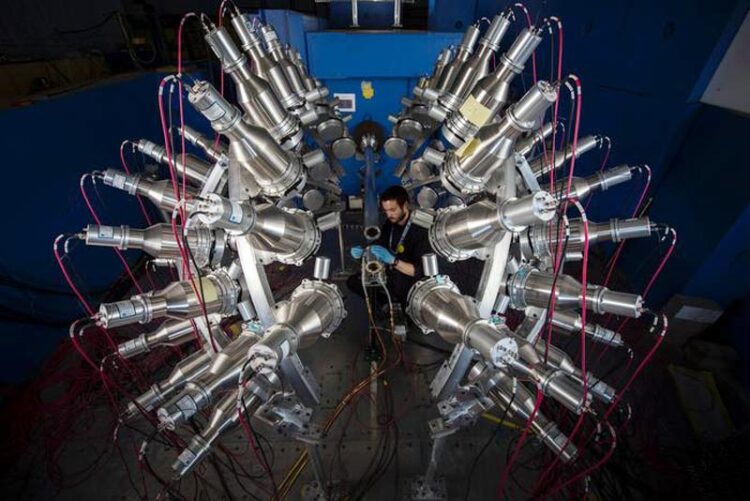Chi-Nu experiment ends with data to support nuclear security, energy reactors

Physicist Keegan Kelly installs a fission-counting target containing approximately 100 milligrams of an actinide of interest for a Chi-Nu experiment. The apparatus includes 54 liquid scintillation neutron detectors and 22 lithium-glass detectors to measure neutrons in different energy ranges.
Credit: Los Alamos National Laboratory
Experiment measures the energy spectrum of neutrons emitted from neutron-induced fission.
The results of the Chi-Nu physics experiment at Los Alamos National Laboratory have contributed essential, never-before-observed data for enhancing nuclear security applications, understanding criticality safety and designing fast-neutron energy reactors. The Chi-Nu project, a years-long experiment measuring the energy spectrum of neutrons emitted from neutron-induced fission, recently concluded the most detailed and extensive uncertainty analysis of the three major actinide elements — uranium-238, uranium-235 and plutonium-239.
“Nuclear fission and related nuclear chain reactions were only discovered a little more than 80 years ago, and experimenters are still working to provide the full picture of fission processes for the major actinides,” said Keegan Kelly, a physicist at Los Alamos National Laboratory. “Throughout the course of this project, we have observed clear signatures of fission processes that in many cases were never observed in any previous experiment.”
The Los Alamos team’s final Chi-Nu study, on the isotope uranium-238, was recently published in Physical Review C. The experiment measured uranium-238’s prompt fission neutron spectrum: the energy of the neutron inducing the fission — the neutron that crashes into a nucleus and splits it — and the potentially wide-ranging energy distribution (the spectrum) of the neutrons released as a result. Chi-Nu focuses on “fast-neutron-induced” fission, with incident neutron energies in millions of electron volts, where there have typically been very few measurements.
Essential data for fission-related work
Together with similar measurements on uranium-235 and plutonium-239, the results from the Chi-Nu experiments are now, in many cases, the dominant source of experimental data guiding modern efforts to evaluate the prompt-fission-neutron spectrum. The data inform nuclear models, Monte Carlo calculations, reactor performance calculations and more.
Actinide elements, and the chain reactions they can undergo, are important for nuclear weapons and energy reactors. (Actinides are the 15 elements, all radioactive, with an atomic number from 89 to 103.) When a nucleus undergoes fission, or splits, several neutrons are released, potentially inducing fission in neighboring nuclei to create the chain reaction. The probability of subsequent reactions in the chain depends on the energy of the fission neutrons.
Conducted at the Weapons Neutron Research facility at the Los Alamos Neutron Science Center (LANSCE), the Chi-Nu experiment relied on a sophisticated apparatus testing several energy ranges. The LANSCE proton beam hits a tungsten target, generating neutrons that travel along a flight path toward the Chi-Nu apparatus. When those neutrons hit the uranium-238 isotope, a fission event, or splitting of the uranium-238 nucleus, can occur and is recorded. Neutrons emitted from the fission event are then measured in either the liquid scintillator or lithium-glass detector arrays, depending on the experiment’s energy range, with both detectors recording flashes of light induced within the detectors by the neutrons.
Future applications of Chi-Nu skills
Researchers continue sketching out the full picture of actinide isotopes. In adjacent work funded by the Nuclear Criticality and Safety Program, the Chi-Nu experimental team is currently collecting and analyzing data on plutonium-240 and uranium-233.
And with the Office of Experimental Sciences measurements now concluded, the team is looking to apply the skills and methodologies they’ve acquired with fission neutron measurements to a series of other isotopes. They are also shifting efforts towards measurements of neutrons emitted from neutron scattering reactions. In these reactions, neutrons transport through a material while depositing energy. The emitted neutron and gamma ray energy and angular spectra are measured along with the probability for the reaction to occur, typically referred to as the neutron scattering cross section.
Paper: “Measurement of the 238U(n, f) prompt fission neutron spectrum from 10 keV to 10 MeV induced by neutrons with 1.5–20 MeV energy.” Physical Review C. DOI: 10.1103/PhysRevC.108.024603
Funding: The U.S. Department of Energy through Los Alamos National Laboratory’s Office of Experimental Science.
Journal: Physical Review C
DOI: 10.1103/PhysRevC.108.024603
Method of Research: Experimental study
Article Title: Measurement of the 238U(n, f) prompt fission neutron spectrum from 10 keV to 10 MeV induced by neutrons with 1.5–20 MeV energy
Article Publication Date: 14-Aug-2023
Media Contact
Brian Keenan
Los Alamos National Laboratory
bkeenan@lanl.gov
Cell: 505-412-8561
Original Source
All latest news from the category: Physics and Astronomy
This area deals with the fundamental laws and building blocks of nature and how they interact, the properties and the behavior of matter, and research into space and time and their structures.
innovations-report provides in-depth reports and articles on subjects such as astrophysics, laser technologies, nuclear, quantum, particle and solid-state physics, nanotechnologies, planetary research and findings (Mars, Venus) and developments related to the Hubble Telescope.
Newest articles

A universal framework for spatial biology
SpatialData is a freely accessible tool to unify and integrate data from different omics technologies accounting for spatial information, which can provide holistic insights into health and disease. Biological processes…

How complex biological processes arise
A $20 million grant from the U.S. National Science Foundation (NSF) will support the establishment and operation of the National Synthesis Center for Emergence in the Molecular and Cellular Sciences (NCEMS) at…

Airborne single-photon lidar system achieves high-resolution 3D imaging
Compact, low-power system opens doors for photon-efficient drone and satellite-based environmental monitoring and mapping. Researchers have developed a compact and lightweight single-photon airborne lidar system that can acquire high-resolution 3D…





















